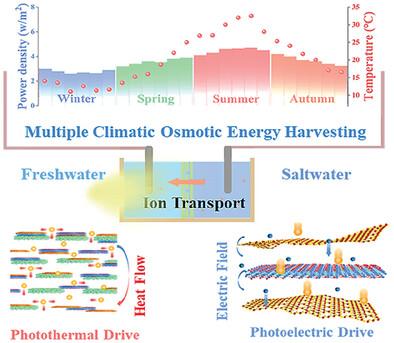IF 13
2区 材料科学
Q1 CHEMISTRY, MULTIDISCIPLINARY
引用次数: 0
摘要
渗透能又称蓝色能源,可促进能源的可持续发展。应用于反向电渗析的各种纳米材料制成的纳米流体膜在提高渗透能的有效转化方面发挥着重要作用。本研究开发了 g-C3N4 改性 MXene/再生纤维素复合纳米流体膜的制备方法。通过优化先进的膜结构,不仅设计出了有序的膜层排列,从而降低了膜阻抗,而且还实现了光电/光热引导离子传输,促进了能量转换。光电效应促进了 g-C3N4 和 MXene 之间的电子和空穴分离,形成局部电场,使当时基于非流体膜的反向电渗析的输出电流从 17 µA 猛增到 28 µA(无光到有光)的峰值电流,功率密度从 0.9 W m-2 增加到 4.3 W m-2。光照 1200 秒后,MXene 通道产生了不均匀的温度梯度,通过光热效应引发了热渗透驱动的离子传输,使输出功率密度达到 5.9 W m-2。光电/光热效应增强了多种气候变化下的渗透能量采集。因此,这项工作拓展了光电/光热引导离子传输的途径,增强了渗透能向电能的转化。本文章由计算机程序翻译,如有差异,请以英文原文为准。

Synergistic Photoelectric/Photothermal Effects Guided Ion Transport for Enhancing Multiple Climatic Osmotic Energy Conversion Efficiency
Osmotic energy, also called blue energy, promotes sustainable energy development. Nanofluidic membranes constructed from various nanomaterials applied in reverse electrodialysis play an important role in enhancing the effective osmotic energy conversion. The fabrication of g-C3N4 modified MXene/regenerated cellulose composite nanofluidic membranes is developed. Optimization of advanced membrane structure not only designed a well-ordered layer arrangement resulting in low membrane impedance but also enabled photoelectric/photothermal guided ion transport to promote energy conversion. The photoelectric effect promoted the separation of electrons and holes between g-C3N4 and MXene to form a local electric field, causing the output current of thenanofluidic membrane-based reverse electrodialysis to jump sharply from 17 µA to a peak current of 28 µA (no light to light) and increasing the power density from 0.9 W m−2 to 4.3 W m−2. After 1200 s of illumination, the MXene channel created an inhomogeneous temperature gradient that triggered ion transport driven by thermal osmosis through the photothermal effect, resulting in an excellent output power density of 5.9 W m−2. Photoelectric/photothermal enhanced osmotic energy harvesting over multiple climate changes. Thus, this work expands the way of photoelectric/photothermal guided ion transport to enhance the conversion of osmotic energy into electrical energy.
求助全文
通过发布文献求助,成功后即可免费获取论文全文。
去求助
来源期刊

Small
工程技术-材料科学:综合
CiteScore
17.70
自引率
3.80%
发文量
1830
审稿时长
2.1 months
期刊介绍:
Small serves as an exceptional platform for both experimental and theoretical studies in fundamental and applied interdisciplinary research at the nano- and microscale. The journal offers a compelling mix of peer-reviewed Research Articles, Reviews, Perspectives, and Comments.
With a remarkable 2022 Journal Impact Factor of 13.3 (Journal Citation Reports from Clarivate Analytics, 2023), Small remains among the top multidisciplinary journals, covering a wide range of topics at the interface of materials science, chemistry, physics, engineering, medicine, and biology.
Small's readership includes biochemists, biologists, biomedical scientists, chemists, engineers, information technologists, materials scientists, physicists, and theoreticians alike.
 求助内容:
求助内容: 应助结果提醒方式:
应助结果提醒方式:


